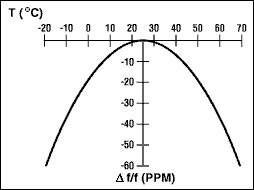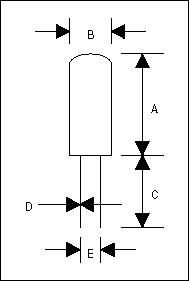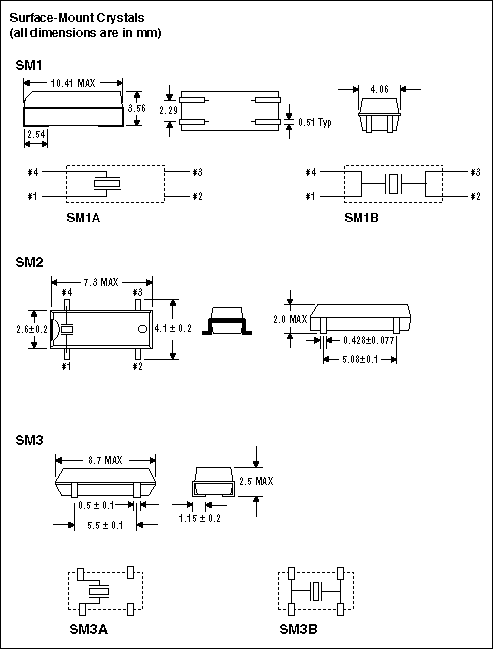All Maxim real-time-clock (RTC) products require an external 32.768kHz watch crystal for use on their on-board crystal oscillator circuit. Except for this crystal, no other external components are required. Selection of the external crystal varies depending on the end application. Considerations are operating temperature range, package style / size, crystal load capacitance, and cost.
Crystal Manufacturers There are many crystal manufacturers for 32.768kHz "watch crystals." A few of them are listed below, along with their web addresses for quick access to technical details regarding crystals.
| Manufacturer | Website |
| Raltron | http: // |
| ECS INC International | http: // |
| SaRonix | http: // |
| Abracon Corporation | http: // |
| Fox Electronics | http: // |
| M-tron | http: // |
| Caliber Electronics | http: // |
| Parameter | Symbol | Min | Typ | Max | Units |
| Frequency | f | 32.768 | kHz | ||
| Equivalent Series Resistance (ESR) | Rs | 35 | 60 | KΩ | |
| Frequency Stability | K | -0.028 | -0.040 | PPM / (Δ ° C) ² | |
| Turnover Temperature | To | +20 | +30 | ° C | |
| Drive Level | 1.0 | µW | |||
| Aging (first year @ 25 ° C) | -3.0 | +3.0 | PPM | ||
| Load Capacitance | 6pF or 12.5pF | ||||
| Q Factor | Q | 40,000 | 60,000 |

Figure 1. Parabolic temperature curve.
In general, an RTC that uses a 12.5pF crystal will have a timekeeping current of 1.7X more than an RTC that uses a 6pF crystal (that is, 6pF RTC current = 300nA @ 2V whereas 12.5pF RTC current = 500nA @ 2V). Timekeeping current is that measured when there is no serial bus activity and the RTC is only using current to run its 32.768kHz oscillator and count real time. A standard, low-cost, 50ma-hr, lithium, backup battery powers an RTC with timekeeping current of less than 570nA for up to 10 years.
A 12.5pF load crystal oscillator is somewhat more stable and less susceptible to noise and PCB layout stray capacitance than a 6pF load crystal oscillator. This is partly due to the capacitance from each crystal pin to ground, internal to the RTC, which is 25pF per pin for the 12.5pF crystal RTC and 12pF for the 6pF crystal RTC.
There are also inventory issues for 32.768kHz watch crystals. Load crystals at 12.5pF are readily available through many distributors. Load crystals at 6pF are not as readily available and can require a minimum-quantity order to procure. Check with your local supplier for availability and price.
It is important to use the correct specified crystal with an RTC, for the wrong crystal can cause as much as a 100ppm error in the 32.768kHz oscillator frequency, which translates to a 4.3-minute error over a one-month period. In addition, the wrong crystal can cause excessive timekeeping current or failure of the oscillator to start properly. Through-Hole Leaded Crystals There are three common packages for through-hole leaded crystals. They are available in both 6pF and 12.5pF crystal loads. These package styles are shown below, along with manufacturers who offer such packages.

Figure 2. Package for through-hole leaded crystals.
| REF | TH1 | TH2 | TH3 |
A | 5.0 max | 6.0 max | 8.3 max |
B | 1.5 max | 2.0 max | 3.2 max |
C | 4.3 min | 4.0 min | 9.0 min |
D | 0.17 +/- 0.05 | 0.2 +/- 0.15 | 0.3 +/- 0.07 |
E | 0.45 | 0.7 +/- 0.15 | 1.1 +/- 0.2 |
Note: Dimensions in mm
| Manufacturer | Crystal Load | Operating Temperature Range (° C) | Frequency Tolerance @ 25 ° C | Part Series | Package Style |
Raltron | 12.5pF optional; 6pF optional | -10 to +60 | +/- 20PPM | R145 | TH1 |
ECS INC International | 12.5pF optional; 6pF optional | -10 to +60 | +/- 20PPM | ECS-1X5 | TH1 |
SaRonix | TH1 | ||||
Abracon Corporation | TH1 | ||||
Fox Electronics | 12.5pF | -20 to +60 | +/- 20PPM | NC15 | TH1 |
M-tron | 12.5pF optional; 6pF optional | -20 to +70 | +/- 30PPM +/- 20PPM | MMCC-3 | TH1 |
Caliber Electronics | 12.5pF | -10 to +60 | +/- 20PPM | AWT3 | TH1 |
| Manufacturer | Crystal Load | Operating Temperature Range (° C) | Frequency Tolerance @ 25 ° C | Part Series | Package Style |
| Raltron | 12.5pF standard; 6pF optional | -10 to +60 | +/- 20PPM | R26 | TH2 |
| ECS INC International | 12.5pF | -40 to +85 | +/- 20PPM | ECS-2X6-FL | TH2 |
| SaRonix | 6pF optional; 12.5pF optional | -10 to +60 | +/- 20PPM | NTF3226 | TH2 |
| Abracon Corporation | 12.5pF standard; 6pF optional | -10 to +60 -40 to +85 optional | +/- 20PPM +/- 10PPM +/- 5PPM | AB26T | TH2 |
| Fox Electronics | 12.5pF | -20 to +60 | +/- 20PPM | NC26 | TH2 |
| M-tron | 12.5pF | -20 to +70 | +/- 30PPM +/- 20PPM | MMCC-2 | TH2 |
| Caliber Electronics | 12.5pF | -10 to +60 | +/- 20PPM | AWT2 | TH2 |
| Manufacturer | Crystal Load | Operating Temperature Range (° C) | Frequency Tolerance @ 25 ° C | Part Series | Package Style |
| Raltron | 12.5pF standard; 6pF optional | -10 to +60 | +/- 20PPM | R38 | TH3 |
| ECS INC International | TH3 | ||||
| SaRonix | 12.5pF | -10 to +60 | +/- 20PPM | NTF3238 | TH3 |
| Abracon Corporation | 12.5pF standard; 6pF optional | -10 to +60 -40 to +85 optional | +/- 20PPM +/- 10PPM +/- 5PPM | AB38T | TH3 |
| Fox Electronics | 12.5pF | -20 to +60 | +/- 20PPM | NC38 | TH3 |
| M-tron | 12.5pF | -20 to +70 | +/- 30PPM +/- 20PPM | MMCC-1 | TH3 |
| Caliber Electronics | 12.5pF | -10 to +60 | +/- 20PPM | AWT | TH3 |

Figure 3. Surface-mount crystals (all dimensions are in mm).
| Manufacturer | Crystal Load | Operating Temperature Range (° C) | Frequency Tolerance @ 25 ° C | Part Series | Package Style |
| Raltron | 12.5pF | -10 to +60 | -10 to +60 | RSM200SA RSM200SB | SM1A SM1B |
| Raltron | 6pF 12.5pF | -40 to +85 | +/- 20PPM +/- 50PPM +/- 100PPM | RSE B RSE A | SM1B SM1A |
| ECS INC International | 12.5pF standard 6pF optional | -40 to +85 | +/- 20PPM | ECX-205 ECX-206 | SM1B SM1A |
| SaRonix | 12.5pF | -40 to +85 | +/- 20PPM | 32S12B 3212SA | SM1B SM1A |
| Abracon Corporation | 12.5pF standard 6pF optional | -40 to +85 | +/- 20PPM +/- 25PPM +/- 30PPM | ABS35A ABS35B | SM1B SM1A |
| Fox Electronics | 12.5pF | -40 to +85 | +/- 20PPM | FSM327 | SM1B |
| M-tron | 12.5pF | -20 to +70 | +/- 20PPM | SSX2010 SSX2020 | SM1B SM1A |
| Caliber Electronics | 12.5pF | -20 to +70 | +/- 20PPM | AWS2A AWS2B | SM1B SM1A |
| Manufacturer | Crystal Load | Operating Temperature Range (° C) | Frequency Tolerance @ 25 ° C | Part Series | Package Style |
| Raltron | 6pF 12.5pF | -40 to +85 | +/- 20PPM +/- 50PPM +/- 100PPM | RSE H2 | SM2 |
| ECS INC International | 6pF 12.5pF | -40 to +85 | +/- 20PPM | ECX-3TA | SM2 |
| SaRonix | SM2 | ||||
| Abracon Corporation | 12.5pF standard 6pF optional | -40 to +85 | +/- 20PPM +/- 25PPM +/- 30PPM | ABS20G | SM2 |
| Fox Electronics | 12.5pF | -40 to +85 | +/- 20PPM | FSP | SM2 |
| Manufacturer | Crystal Load | Operating Temperature Range (° C) | Frequency Tolerance @ 25 ° C | Part Series | Package Style |
| Raltron | 12.5pF | -10 to +60 | +/- 20PPM | RSM200S | SM3A |
| Raltron | 6pF 12.5pF | -40 to +85 | +/- 20PPM +/- 50PPM +/- 100PPM | RSE C RSE D | SM3A SM3B |
| ECS INC International | 12.5pF standard 6pF optional | -40 to +85 | +/- 20PPM | ECX-306I | SM3A |
| SaRonix | 12.5pF | -40 to +85 | +/- 20PPM | 32S12C | SM3A |
| Abracon Corporation | 12.5pF standard 6pF optional | -40 to +85 | +/- 30PPM +/- 20PPM +/- 25PPM | ABS25 | SM3A |
| Fox Electronics | 12.5pF | -40 to +85 | +/- 20PPM | FSR327 FST327 | SM3A SM3B |
| M-tron (SM3 pkg w / 2mm height) | 12.5pF | -40 to +85 | +/- 30PPM | SX1575 | SM3A |
| M-tron | 12.5pF | -20 to +70 | +/- 30PPM | SX1555 | SM3A |
| Package Style | Price in 1K Qty * |
| TH1 | $ 0.62 |
| TH2 | $ 0.18 |
| TH3 | $ 0.18 |
| SM1 | $ 0.62 |
| SM2 | $ 0.82 |
| SM3 | $ 0.62 |
* Catalog distributor pricing in $ US
The Rectifier Bridge is to seal the rectifier in a shell. Divided into full bridge and half bridge. The full bridge seals the four diodes of the connected bridge rectifier circuit. The half bridge is to seal together half of the four diode bridge rectifiers. Two bridges can be used to form a bridge rectifier circuit. One half bridge can also form a full-wave rectifier circuit with a center tap of the transformer. Rectifier circuit and operating voltage.
Rectifier Bridge
Diode Bridge Rectifier,3 Phase Bridge Rectifier,Rectifier Bridge,Rectifier Bridge
Dongguan Agertech Technology Co., Ltd. , https://www.agertechcomponents.com